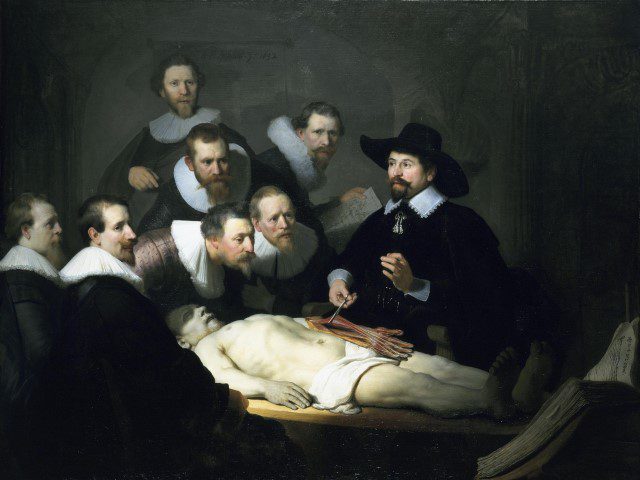Hektoen International, A journal of medical humanities has several articles motivated by Rembrandt's painting of The Anatomy Lesson of Dr. Nicolaes Tulp
One of the articles is Rembrandt – The Anatomy Lesson of Dr. Nicolaes Tulp by Tan Chen. It says in part:
"Commissioned for display in the Guild Room, the painting offers a glimpse into important changes in the world of medicine. Gone are the days of public executions and dissection, and a much more subdued method has taken over. In the modern world executions are no longer public, and anatomy students no longer know the name of their corpse. Great care is taken to remain respectful of the deceased, and in doing so the hands and feet are covered so as to take away the intimacy many associate with these body parts. Today it is easy for a person to donate their body to science and allow anatomy students a real look into the human body, whereas before no choice was given.
The corpse in Rembrandt’s The Anatomy Lesson of Dr. Nicolaes Tulp gives the painting a more macabre feeling. The body being dissected is that of Aris Klindt (an alias for Adriaan Adriaanszoon), an armed robber sentenced to death by hanging. A public dissection was only a yearly event, and all bodies being dissected were that of criminals."
***********
Our views about cadavers have changed, and continue to change. Here's a 2016 story from the NY Times:
New York State Bans Use of Unclaimed Dead as Cadavers Without Consent
By NINA BERNSTEINAUG. 19, 2016
One of the articles is Rembrandt – The Anatomy Lesson of Dr. Nicolaes Tulp by Tan Chen. It says in part:
"Commissioned for display in the Guild Room, the painting offers a glimpse into important changes in the world of medicine. Gone are the days of public executions and dissection, and a much more subdued method has taken over. In the modern world executions are no longer public, and anatomy students no longer know the name of their corpse. Great care is taken to remain respectful of the deceased, and in doing so the hands and feet are covered so as to take away the intimacy many associate with these body parts. Today it is easy for a person to donate their body to science and allow anatomy students a real look into the human body, whereas before no choice was given.
The corpse in Rembrandt’s The Anatomy Lesson of Dr. Nicolaes Tulp gives the painting a more macabre feeling. The body being dissected is that of Aris Klindt (an alias for Adriaan Adriaanszoon), an armed robber sentenced to death by hanging. A public dissection was only a yearly event, and all bodies being dissected were that of criminals."
***********
Our views about cadavers have changed, and continue to change. Here's a 2016 story from the NY Times:
New York State Bans Use of Unclaimed Dead as Cadavers Without Consent
By NINA BERNSTEINAUG. 19, 2016
"The law bans the use of unclaimed bodies as cadavers without written consent by a spouse or next of kin, or unless the deceased had registered as a body donor. It ends a 162-year-old system that has required city officials to appropriate unclaimed bodies on behalf of medical schools that teach anatomical dissection and mortuary schools that train embalmers."
*********
And here's the page for Stanford's Willed Body Donation Program
"Once you register to become a donor to the Willed (Whole) Body Program, Stanford’s Division of Clinical Anatomy will keep your name and contact information on file. Upon your death, a caregiver or family member must contact us right away. We take calls 24 hours/day, every day of the year. We will arrange for a funeral home to transport your body to Stanford Medical School, where it may be used to teach students about the structure of the human body and for furthering medical and scientific knowledge.
Once study of the body is complete, we will arrange for cremation. (The study period may range from one month to two years, but it is typically about a year in duration.) At the time of donation, your family will be asked whether they wish for the cremated remains to be returned or whether they would like us to arrange for interment. Our faculty, students, and staff are very grateful for the kindness our donors have extended, and bodies are treated with the greatest respect while in our care."

No comments:
Post a Comment
Note: Only a member of this blog may post a comment.